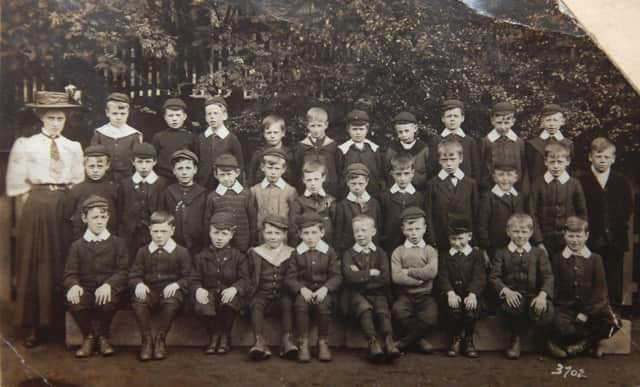Nostalgia with Margaret Watson: Children in these parts were set to work as young as three and four


Margaret Watson writes: There was a time when the education of children was at the bottom of the list of priorities and many families saw their offspring as necessary additions to their workforce.
Children in these parts were set to work as young as three and four , helping their parents both in the home and in their place of work.
Advertisement
Hide AdAdvertisement
Hide AdChildren whose parents were hand-loom weavers were taught at a very early age how to wind bobbins.
And, pity the poor children of coal miners, who were expected to work alongside their fathers as young as six and seven, sometimes 12 hours a day.
School wasn’t compulsory and parents who did see the advantage of educating their children had to pay for it.
There was little sentimentality shown towards children, especially during the Industrial Revolution when many of them suffered great hardships.
Advertisement
Hide AdAdvertisement
Hide AdEven when Acts of Parliament were introduced to ease their burden and to improve their education, their lives were still bleak indeed.
Many children went to school barefoot and here in Dewsbury a special fund ‘Boots for the Bairns’ was set up to help eliminate this kind of poverty.
Over the years the care of children began to improve and in the early 1900s, Dewsbury Education committee started to take an interest in all aspects of children’s lives in addition to their schooling.
They began taking a closer interest in their nutrition and appointed school medical officers to report on the health of children attending Dewsbury schools.
Advertisement
Hide AdAdvertisement
Hide AdIn 1915, one medical officer reported that many children were suffering from poor nutrition probably because their fathers were away at war and their mothers had to go out to work.
He reported: “Female labour has increased and many mothers have gone to work and the result has been the improper feeding of their children.
“It is strange but true, but when the father is not at home meals are generally make-shift and the children have just tea and sweet stuff rather than meat and puddings.
“Mothers working in a factory or elsewhere, as a rule, will make no proper dinner for the children. I have seen children have a midday meal of just bread and jam.”
Advertisement
Hide AdAdvertisement
Hide AdDespite reports like this, it was many years before school meals were provided to ensure children got at least one good meal a day – and children from poor families were eventually able to get them free.
Children who had parents to look after them, no matter how poor or deprived, knew from an early age they were better off than if they had been placed in the workhouse.
Here in Dewsbury there was a workhouse overseen by Guardians of the Poor Law and sometimes entire families had to be placed there during times of extreme poverty.
The cost of their upkeep was always a concern and the Guardians often “boarded” children out as young as five or six as apprentices, much in the way as the fictional Oliver Twist was.
Advertisement
Hide AdAdvertisement
Hide AdThe children of vagrants, those who tramped the country, were often taken from their parents and adopted by the Guardians, even though there were no signs of cruelty from parents.
The Guardians thought they knew what was best for children and tramping around the countryside with their parents was not the right way to bring up children.
A Dewsbury Catholic priest, Father Mitchell, who was a member of the Board of Guardians, did not agree with this practice and tried to stop it.
When the idea was first proposed in 1909, he objected that the Master of the Workhouse should be allowed to detain the children of vagrants with a view to their being adopted by the Guardians, rather than be allowed to go with their parents on to the next town.
Advertisement
Hide AdAdvertisement
Hide AdAlthough Fr Mitchell was in sympathy with members of the Board in their wish to remedy the evil of children being trailed from place to place by their parents, he felt it was a drastic procedure.
He felt this evil might be better met by other methods because taking children away from their parents was punishing the children more than the parents.
Threatening parents with prosecution, he said, might induce them to give up their wandering and take better care of their children.
Instead of agreeing to adopt the children, he felt the Board should be taking suitable measures to secure the betterment of the condition of the children.
Advertisement
Hide AdAdvertisement
Hide AdThe Reverend J E Crabtree, of Birkenshaw, said he could not agree with Father Mitchell because in his opinion, in nine cases out of ten vagrants became vagrants entirely through their own fault.
“The best thing that can happen to some children is to remove them from undesirable surroundings into decent conditions of life,” he said.
“By allowing such children to remain “on the road” we are developing vagrants in embryo. Neglect and cruelty are suffered by such children day by day.”
Father Mitchell’s resolution was lost, and the resolution to have them adopted, in certain cases, was adopted by a large majority.
Advertisement
Hide AdAdvertisement
Hide AdThe photograph on this page shows a class of children in Thornhill Lees only a few years after the Guardians of the Workhouse took this decision.
Fortunately these children pictured in 1912 came from a very different background and looked well cared for.
They weren’t in danger of going into the workhouse and being separated from their parents, but not all children in those days were so lucky.